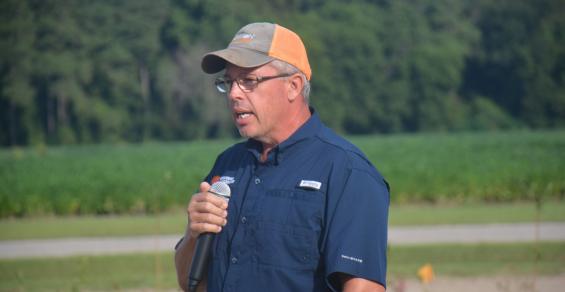Good blueberry soils are forested areas with a lot of debris.
There’s no disputing the cold, hard fact there are blueberry soils and non-blueberry soils. The challenge is to improve non-blueberry soils so they can produce healthy, high-yielding plants.
“Blueberry soils are basically black sand that has really high organic matter. That’s not a prevalent soil type in a lot of locations across South Carolina. About 5% of the soil types located in the eastern part of the state are blueberry soils. Everywhere else has non-blueberry soils. If you’re really going to try to grow blueberries in non-blueberry soil, you’re really going to have to amend the soil,” explains Bruce McLean, Clemson area Extension horticulture agent in Marion, Horry, Dillon and Marlboro Counties, S.C.
McLean notes that the standard soil amendment used in the Southeast is pine bark. The challenge with pine bark is often finding a good supply since other industries also use pine bark. To expand soil amendment options in South Carolina and the Southeast, McLean is leading a Clemson research study now in its first year examining different forestry-based material that could serve as good soil amendments for blueberries.
The five-year study is being conducted at three sites in South Carolina with three different soil types: The Pee Dee Research and Education Center in Florence with sandy clay loam soils; the Sandhill Research and Education Center in Columbia with deep, sandy soils; and the Musser Fruit Research Farm located near the Clemson campus with clay loam soils.
Speaking at the Pee Dee Research Station Field Day Sept. 1, McLean said the concept of soil amendments in blueberries is to take pine park and roto-till it into the soil, then top-dressing the rest. In the research, McLean’s team is looking at different material options, using pine straw and a whole-tree grind, including pine cones.
They are examining the use of pine straw alone; a two-way mixture of 75% pine straw and 25% pinewood; a whole-tree grind, including pine cones; and a three-way mixture of pine straw, pinewood, and hardwoods. The goal is to have an amendment that is highly decomposed.
“We are looking at different parameters, different dynamics. We are examining qualitative things: How vigorous is the plant and how does it come back the following year? We are looking at things we can quantify, the diameter of the plant at the base, the overall height and width of the plant,” he said.
“We are looking at dry matter where we are actually going to sacrifice some of the plants, dry them down and then do a comparison of how the plants actually adapt to the different soil types,” he said.
In the research, McLean and his team are examining three different blueberry varieties planted five plants to a plot with three replications and five soil types. Soil amendments are applied at six cubic yards per row, which equates out to 185 to 190 yards per acre. McLean says the plots are sectionally scaled to the industry standard for commercial blueberry production.
The goal of the Clemson research is the create the right soil conditions for blueberries. Researchers want to determine if the different soils amendments can work in commercial blueberry production.
“There is a lot of anecdotal evidence that says, ‘yes this works, it works very well.’ We are trying to replicate what we find in nature to create good blueberry soils. Good blueberry soils are forested areas with a lot of debris,” he explains.
The goal is to replicate these soil conditions in commercial blueberry plots



